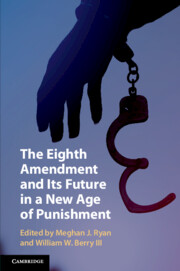Book contents
- The Eighth Amendment and Its Future in a New Age of Punishment
- The Eighth Amendment and Its Future in a New Age of Punishment
- Copyright page
- Dedication
- Contents
- Contributors
- Preface
- Introduction
- Part I A History of the Eighth Amendment
- Part II The Landscape of Eighth Amendment Doctrine
- Part III The Future of the Eighth Amendment
- Index
Introduction
Published online by Cambridge University Press: 03 June 2020
- The Eighth Amendment and Its Future in a New Age of Punishment
- The Eighth Amendment and Its Future in a New Age of Punishment
- Copyright page
- Dedication
- Contents
- Contributors
- Preface
- Introduction
- Part I A History of the Eighth Amendment
- Part II The Landscape of Eighth Amendment Doctrine
- Part III The Future of the Eighth Amendment
- Index
Summary
The Eighth Amendment to the United States Constitution proscribes governments from imposing “cruel and unusual punishments,” as well as excessive bail and fines. The Amendment has roots in a similar provision in the English Bill of Rights, which historically sought to prevent extreme punishments like the whipping, pillorying, defrocking, and life imprisonment of Titus Oates for perjury. Despite the historical importance of the Amendment, U.S. courts and scholars have given the Amendment and its prohibitions relatively little attention. In particular, the Supreme Court has construed its text quite narrowly, especially outside of the capital context.
- Type
- Chapter
- Information
- Publisher: Cambridge University PressPrint publication year: 2020

